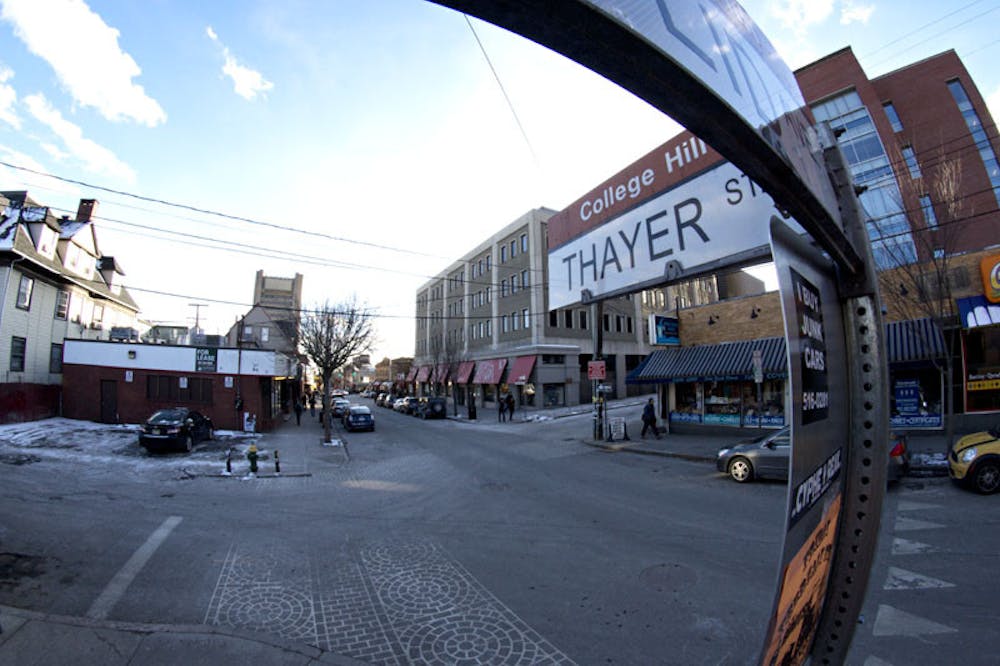Consultants will submit bids at a Board of Contract and Supply meeting in City Hall this afternoon for a project spearheaded by a committee of College Hill stakeholders to focus on the commercial and residential development of Thayer Street and the surrounding area. A committee headed by the City of Providence’s Department of Planning and Development will review the proposals and accept the plan from the lowest bidder that best adheres to the city’s guidelines and goals within 60 days, according to the Request for Proposals published by the city in December.
The proposals will be evaluated by a small committee of representatives from the Department of Planning and Development, the College Hill Neighborhood Association, the Thayer Street District Management Authority, the Providence Preservation Society and the University, who will be working together to craft a plan to improve the area’s economy by drawing a new market of retailers and consumers to College Hill.
As the committee considers how to modernize the study area — which is the portion of College Hill enclosed by Thayer Street, Lloyd Avenue, Hope Street and Waterman Street — it aims to address the concerns of stakeholders who wish to beautify the cityscape, maintain the safety of the community and preserve the area’s history, according to the Request for Proposals. Consultants will be chosen based on their work experience, ability to cooperate and communicate with the public and the quality and cost-effectiveness of their plans.
This is not the first time individual stakeholders have initiated discussions about transforming the economy and conditions of Thayer Street. Over the years, groups in the area have disagreed over particular development projects instead of collaborating to improve the area as a whole, said Mike McCormick, assistant vice president for planning, design and construction in the Department of Facilities Management.
Now, instead of focusing on projects on a contentious case-to-case basis, the committee — which aims to represent all parties with vested interests in the area — looks to revitalize Thayer Street so that it can be successful and sustainable, McCormick said.
Past efforts to expand the University’s campus have been met with resistance by College Hill residents, said James Hall, executive director of the Providence Preservation Society, as the two parties clashed over their diverging interests, leaving neither wholly satisfied with Thayer Street’s development. Though the University “has become a much better neighbor” over the years through its support for the neighborhood’s historic preservation efforts and annual payments in lieu of taxes to the city, “old suspicions die hard,” Hall said.
A more cohesive vision of Thayer Street’s future can be realized if all parties with a vested interest in a prosperous Thayer Street collaborate with one another, McCormick said.
Despite its prime location near the University’s campus and easy accessibility from downtown, Thayer Street lacks many businesses that could serve the community and attract tourists to the area, said Ed Bishop ’54 P’86 P’91, chair of the Thayer Street District Management Authority and board member of the College Hill Neighborhood Association who owns properties in the area. Bishop’s 2004 and 2008 bids to build a luxury $35 million hotel on Brook Street were shot down in the face of opposition from neighborhood residents, and a 2011 proposal for the same project is still pending.
Due to the absence of a local grocery store or pharmacy for residents and attractions — like art galleries and boutiques — for tourists, Thayer Street currently serves primarily as “a food court,” Bishop said. In order for Thayer Street to appeal to residents, students and visitors, there must be a balance of restaurant and retail establishments, said Allison Spooner, president of the College Hill Neighborhood Association.
In order to make the study area a physically beautiful, financially successful and sustainable place to live and visit, the area’s utilities and landscape should be improved by providing additional parking, wider sidewalks and new signage, Bishop said. Planting new greenery, restoring older buildings, reestablishing the boundaries of the neighborhood’s historic district and demolishing ugly buildings — like the strip that includes FroYo World and the Metro Mart — could help beautify the area, Hall noted.
In ongoing talks with the Rhode Island Public Transit Authority, the Department of Planning has discussed constructing a streetcar line on fixed rail to connect Thayer Street to the Jewelry District and to areas in downtown Providence to increase ridership and support economic growth, said Amy Pettine, RIPTA’s director of planning and marketing. While the streetcar plans will require additional funding, Pettine added, RIPTA also plans to implement improvements, including new safety measures, to the Thayer Street tunnel with a recent $1 million grant from the federal government.
The University hopes students can be involved in the development process due to the regularity with which many use the Thayer Street area, McCormick said. Though many will not be on campus long enough either to understand the context for many of the concerns or to see the projects implemented, Hall said, it is time to look at how to best utilize the area and plan thoughtfully for its future growth.

ADVERTISEMENT




